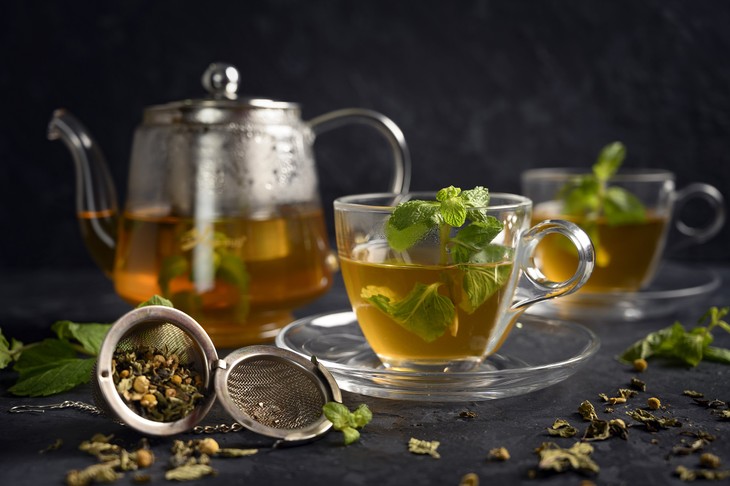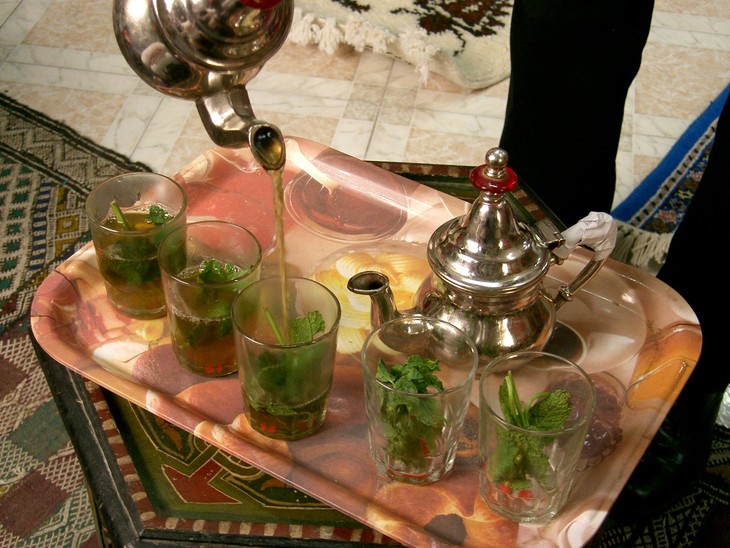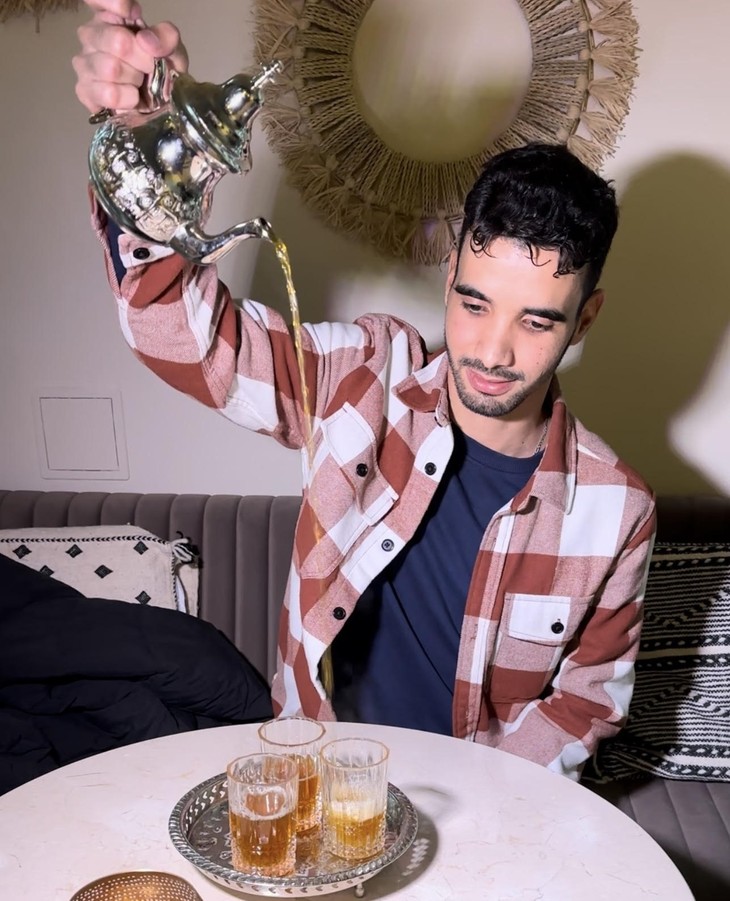(VOVWORLD) - Tea has, for centuries, been an indispensable part of the Moroccans’ everyday culture. Not only is tea a drink to quench the thirst, but it is also a symbol of hospitality in this country. Today, VOV’s “Cultural Rendezvous” takes you on a fragrant journey of Moroccan tea with M’barek Alhaddar, a Moroccan currently living in Budapest.
 Moroccan Mint Tea (Photo: Sarkar Sayantan/Wikimedia Commons) Moroccan Mint Tea (Photo: Sarkar Sayantan/Wikimedia Commons) |
“I think I’ve been drinking tea since I was a kid. I love drinking tea and usually in Morocco, we drink tea after each meal. It is a tradition to drink tea mainly in the morning and evening. Some people find the opportunity to drink tea whenever they have free time. If I can give an example, whenever my dad was in front of our house and he saw a friend coming, the first thing he would say is “come, come, let’s have tea together. On the streets of Morocco, you will find people sitting in front of their house with a table and tea set. Sometimes, it’s not only one person, you can see one table with 4-5 people sitting with just one teapot and they are drinking and sharing the tea with one another, watching football games or discussing political issues.” said M’barek Alhaddar, who was born and raised in Morocco.
With 1.22 kg of tea consumed per capita every year, this beverage has a special, constant place in Moroccan culture. The hot beverage was popularized in Morocco by British merchants in the mid 19th century. Nevertheless, the Moroccans created their own tradition by skipping the milk and adding spearmint, thus creating the unique Maghrebi mint tea.
Once a luxurious commodity for the upper class, tea has gradually made its way to every household in Morocco. While the flavors and complimentary herbs may vary, mint tea is still a go to choice for most people.
M’barek said: “In the majority of ceremonies, I can say that mint tea is the primary type of tea used. However, you can use ‘gunpowder tea’ from either Moroccan brands or from China. And the special thing about Moroccan tea is that you frequently add mint leaves and some sugar to make it sweeter. But it varies from region to region. Usually it starts with boiling water, after which you put the gunpowder tea in. Then you mix everything together. Then in the last step you add the mint leaves and sugar. You boil it again and you have traditional Moroccan tea.”
 M’barek Alhaddar, a Moroccan currently living in Budapest, said "tea time" has always been a part of his life since childhood. (Photo: Hong Phuong) M’barek Alhaddar, a Moroccan currently living in Budapest, said "tea time" has always been a part of his life since childhood. (Photo: Hong Phuong) |
When combined with traditional cookies like Kaab el Ghazal or Chebakia, the taste of Maghrebi tea is significantly enhanced. Still, the appeal of Moroccan tea not only lies in its mesmerizing flavors. The ceremony itself is also a feast for the eyes. A typical tea ceremony lasts from 30 minutes to one hour. After brewing, the tea is then poured from a high distance, creating the illusion of a steamy waterfall flowing down into a cup. Some do this to masterfully create a layer of foam encasing the tea, but according to M’barek, the main point of this pouring technique is to let the flavors bloom.
He added: "“I can say this action in itself is an art. It is a tradition in Morocco for various reasons. Pouring tea from a height means that you are mixing the tea in the meantime to make sure everything is blended and tastes good. And also, people say that when you are boiling tea, it’s hot so you do this pouring tea to cool it. This is mainly a tradition. The height is up to you and you can go as high as you can. Some professionals can even do it without looking at the teapot, they just look at you and smile while pouring the tea, which is really special. This is also an interesting experience for tourists, so whenever you go to a Moroccan restaurant that has tourists, all of them will ask for their tea to be poured from a height.”
 The traditional Moroccan tea ceremony is known as "Atay Naa Naa". In photo: Moroccan mint tea on a traditional round tray, with tea pot and bowl of sugar. (Photo: Munfarid/Wikimedia Commons) The traditional Moroccan tea ceremony is known as "Atay Naa Naa". In photo: Moroccan mint tea on a traditional round tray, with tea pot and bowl of sugar. (Photo: Munfarid/Wikimedia Commons) |
Another visually-pleasing part of the ceremony is the teaware – a testament to the Moroccans’ exquisite craftsmanship. The teapots are usually silver-plated and engraved with intricate patterns, while the small tea glasses come in different colors.
M’barek Alhaddar said: “Usually in Morocco, we have different teapots. We have teapots made from silver or other metals. We use different metals because they are practical, even when we boil the pot on the stove. It keeps the teapot hot. In each Moroccan ceremony, the teapots are different. If you are having a big ceremony with families, you use the fancy teapots. For example, my mom has different teapots for different occasions. Also, teapots made from metals can survive for a really long time so sometimes, my mom will come and say something like ‘Oh, this teapot is the same age as a small child’.”
 Different teapots are reserved for different occasions. (Photo: Andy Dincher/Wikimedia Commons) Different teapots are reserved for different occasions. (Photo: Andy Dincher/Wikimedia Commons) |
For some people, tea is merely a caffeine booster, yet for Moroccans, tea is a social glue that holds the community together. It is present at every local occasion, from small family gatherings to extravagant wedding ceremonies. When a guest first sets foot in a Moroccan house, tea is most likely the first thing offered by the host. Regarding the future of this tradition in Morocco, especially with competition from so many new and trendy modern beverages, M’barek is optimistic.
He said: “I think even for the younger generations, tea culture still exists. This tea culture will not disappear from Morocco. Even the young generations still enjoy drinking tea and you will see teapots in all families. Right now, we can see people are addicted to coffee or something else, but tea is the main beverage that will always exist in our culture. If you go to coffee shops in Morocco, among different things people order, you will surely see tea because it’s the main reason that people gather and share something. When you drink coffee, you drink from your own cup, but having tea is something you share. You can give everyone a cup of tea from a single pot and it’s a beautiful and ancient tradition.”
It has been two and a half years since M’barek moved to another country. Among the keepsakes he brought, a small, shiny Moroccan tea set sits proudly, reminding him of a beautiful tradition of his home country.
 A Moroccan tea set sits proudly among M’barek Alhaddar's keepsakes to remind him of his home country's traditions. (Photo: Hong Phuong) A Moroccan tea set sits proudly among M’barek Alhaddar's keepsakes to remind him of his home country's traditions. (Photo: Hong Phuong) |